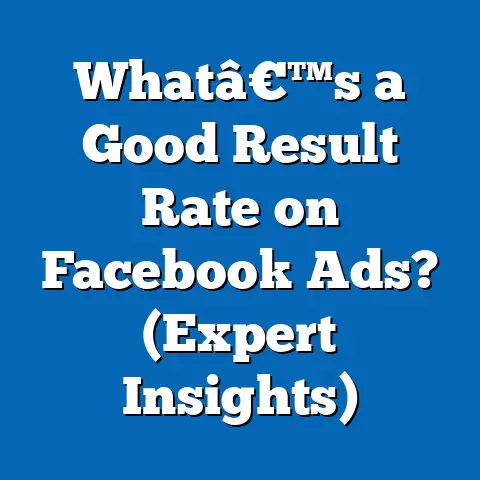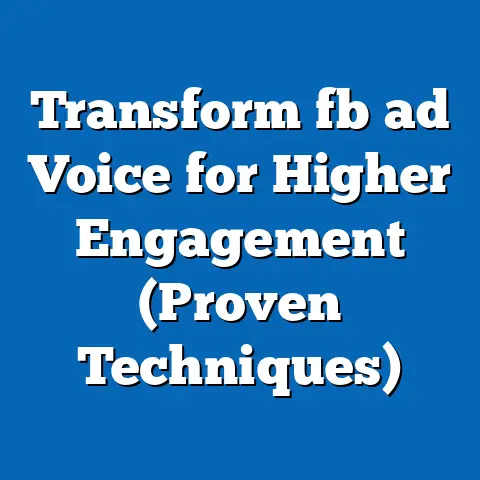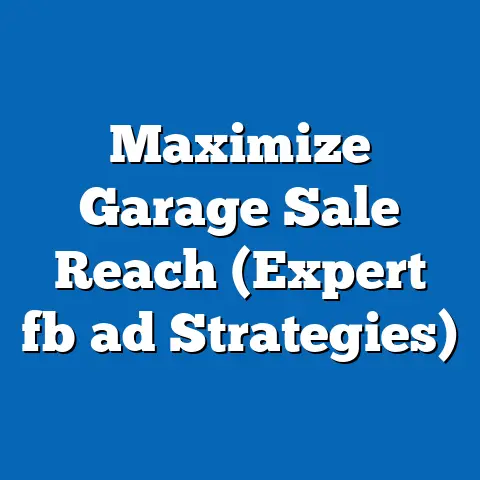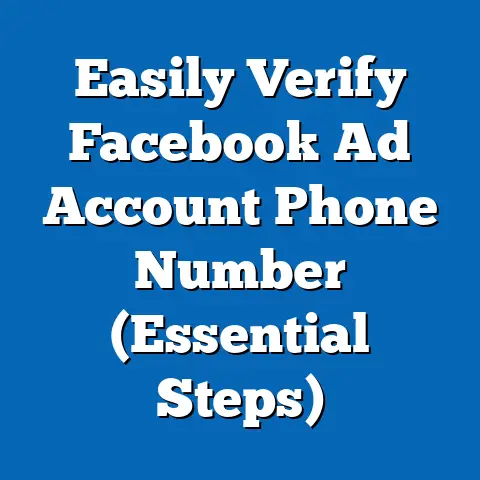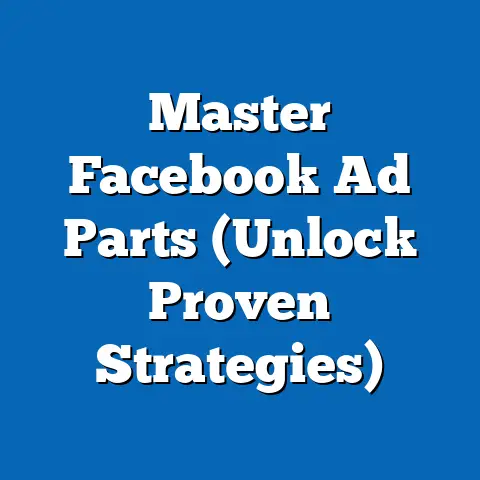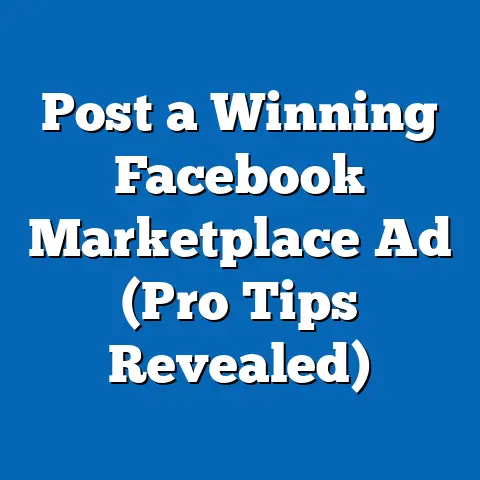Conquer Facebook Ads: Unlock Winning Strategies (Expert Insights)
What if you could transform your small business into a thriving online empire with just a few strategic moves on Facebook? Imagine reaching millions of potential customers with your ads, driving unprecedented traffic to your website, and ultimately, multiplying your revenue. What if the key to unlocking this success was hidden in the intricacies of Facebook’s advertising platform, waiting for you to discover it? I’ve seen it happen, and I’m here to tell you how you can make it happen too.
I remember when I first started running Facebook ads. I was completely overwhelmed. The Ads Manager seemed like a labyrinth, and the sheer number of options was paralyzing. I spent a lot of money on ads that didn’t convert, feeling frustrated and discouraged. But I didn’t give up. I dove deep, learning from every mistake, attending webinars, and experimenting relentlessly. Over time, I cracked the code, and Facebook ads became a powerful tool in my marketing arsenal. Now, I want to share my journey and insights with you, so you can avoid the pitfalls I faced and achieve your own Facebook advertising success.
This guide is designed to be your comprehensive roadmap to conquering Facebook Ads. Whether you’re a complete beginner or have some experience under your belt, I’ll walk you through everything you need to know to create winning campaigns that drive real results. Let’s dive in!
Section 1: Understanding Facebook Ads
Before we jump into the nitty-gritty, it’s crucial to have a solid foundation of what Facebook Ads are and why they matter.
1.1 The Evolution of Facebook Advertising
Facebook advertising has come a long way since its humble beginnings. Initially, it was a simple way for businesses to reach a broad audience. But over the years, it has evolved into a sophisticated, data-driven platform with unparalleled targeting capabilities.
-
Brief History: Facebook introduced its first advertising options in 2004, primarily focused on basic profile targeting. As the platform grew, so did its advertising features. The introduction of the News Feed in 2006 revolutionized how ads were displayed, making them more integrated and engaging.
-
Significant Milestones: Key milestones include the launch of Facebook Ads Manager, which provided a centralized platform for creating and managing campaigns; the introduction of the Facebook Pixel, which enabled precise tracking and retargeting; and the continuous updates to targeting options, allowing advertisers to reach increasingly specific audiences.
-
Current Statistics: As of 2023, Facebook boasts over 2.9 billion monthly active users, making it the most popular social media platform worldwide. According to Statista, Facebook’s advertising revenue in 2022 reached over $117 billion, highlighting its importance as a key advertising channel. Studies have shown that Facebook ads can significantly increase brand awareness, drive website traffic, and generate leads and sales when executed effectively.
Brief History: Facebook introduced its first advertising options in 2004, primarily focused on basic profile targeting. As the platform grew, so did its advertising features. The introduction of the News Feed in 2006 revolutionized how ads were displayed, making them more integrated and engaging.
Significant Milestones: Key milestones include the launch of Facebook Ads Manager, which provided a centralized platform for creating and managing campaigns; the introduction of the Facebook Pixel, which enabled precise tracking and retargeting; and the continuous updates to targeting options, allowing advertisers to reach increasingly specific audiences.
Current Statistics: As of 2023, Facebook boasts over 2.9 billion monthly active users, making it the most popular social media platform worldwide. According to Statista, Facebook’s advertising revenue in 2022 reached over $117 billion, highlighting its importance as a key advertising channel. Studies have shown that Facebook ads can significantly increase brand awareness, drive website traffic, and generate leads and sales when executed effectively.
Takeaway: Understanding the history of Facebook advertising helps you appreciate its current capabilities and potential. The platform is constantly evolving, so staying informed about new features and updates is crucial.
1.2 Why Facebook Ads Matter
In today’s digital marketing landscape, Facebook Ads are not just an option; they’re often a necessity. Here’s why:
-
Importance in Digital Marketing: Facebook Ads offer unparalleled reach and targeting capabilities. With billions of users worldwide, the platform provides access to a massive audience, allowing businesses to connect with potential customers regardless of their location or demographics.
-
Audience Demographics and Reach: Facebook’s diverse user base spans all age groups, income levels, and interests. This means that virtually any business can find its target audience on the platform. The detailed demographic data available on Facebook allows advertisers to create highly targeted campaigns that reach the right people with the right message.
-
Comparison with Other Platforms: Compared to other advertising platforms like Google Ads, Facebook Ads offer more granular targeting options based on interests, behaviors, and demographics. While Google Ads are primarily focused on search intent, Facebook Ads excel at creating demand and reaching users who may not be actively searching for your products or services. Furthermore, Facebook’s visual ad formats (images and videos) tend to be more engaging than text-based ads.
Importance in Digital Marketing: Facebook Ads offer unparalleled reach and targeting capabilities. With billions of users worldwide, the platform provides access to a massive audience, allowing businesses to connect with potential customers regardless of their location or demographics.
Audience Demographics and Reach: Facebook’s diverse user base spans all age groups, income levels, and interests. This means that virtually any business can find its target audience on the platform. The detailed demographic data available on Facebook allows advertisers to create highly targeted campaigns that reach the right people with the right message.
Comparison with Other Platforms: Compared to other advertising platforms like Google Ads, Facebook Ads offer more granular targeting options based on interests, behaviors, and demographics. While Google Ads are primarily focused on search intent, Facebook Ads excel at creating demand and reaching users who may not be actively searching for your products or services. Furthermore, Facebook’s visual ad formats (images and videos) tend to be more engaging than text-based ads.
Takeaway: Facebook Ads are a powerful tool for reaching a large and diverse audience. Their superior targeting capabilities and engaging ad formats make them a valuable addition to any digital marketing strategy.
Section 2: Setting Up for Success
Before launching your first campaign, it’s essential to lay the groundwork for success. This involves defining your goals, identifying your target audience, and crafting compelling ads.
2.1 Defining Your Goals
The first step in any Facebook advertising campaign is to define your goals. What do you want to achieve with your ads? Are you looking to increase brand awareness, generate leads, drive sales, or something else?
-
Importance of Clear Objectives: Having clear, measurable objectives is crucial for tracking your progress and determining the success of your campaigns. Without clear goals, you’ll be flying blind, wasting time and money on ads that don’t deliver the desired results.
-
Aligning Goals with Facebook Features: Facebook offers a variety of advertising objectives, each designed to achieve different goals. For example, if you want to increase brand awareness, you might choose the “Brand Awareness” objective. If you want to generate leads, you might choose the “Lead Generation” objective.
Importance of Clear Objectives: Having clear, measurable objectives is crucial for tracking your progress and determining the success of your campaigns. Without clear goals, you’ll be flying blind, wasting time and money on ads that don’t deliver the desired results.
Aligning Goals with Facebook Features: Facebook offers a variety of advertising objectives, each designed to achieve different goals. For example, if you want to increase brand awareness, you might choose the “Brand Awareness” objective. If you want to generate leads, you might choose the “Lead Generation” objective.
Here are some common Facebook advertising goals and the corresponding objectives you can use:
- Brand Awareness: Choose the “Brand Awareness” or “Reach” objective. These objectives are designed to show your ads to as many people as possible within your target audience.
- Website Traffic: Choose the “Traffic” objective. This objective is designed to drive traffic to your website.
- Engagement: Choose the “Engagement” objective. This objective is designed to increase engagement with your Facebook page or posts.
- Lead Generation: Choose the “Lead Generation” objective. This objective allows you to collect leads directly on Facebook using lead forms.
- Sales: Choose the “Conversions” or “Catalog Sales” objective. These objectives are designed to drive sales on your website or through your product catalog.
Takeaway: Clearly defining your goals and aligning them with Facebook’s advertising objectives is the foundation for a successful campaign.
2.2 Identifying Your Target Audience
Knowing your target audience is essential for creating effective Facebook Ads. Who are you trying to reach? What are their interests, demographics, and behaviors?
-
Audience Segmentation and Targeting: Facebook offers a variety of targeting options, allowing you to reach specific segments of your audience based on demographics (age, gender, location), interests (hobbies, activities, pages they like), and behaviors (purchase history, online activity).
-
Tools for Audience Insights: Facebook Audience Insights is a powerful tool for learning more about your target audience. It provides detailed information about their demographics, interests, behaviors, and purchase habits. You can use this information to create more targeted and effective ads.
Audience Segmentation and Targeting: Facebook offers a variety of targeting options, allowing you to reach specific segments of your audience based on demographics (age, gender, location), interests (hobbies, activities, pages they like), and behaviors (purchase history, online activity).
Tools for Audience Insights: Facebook Audience Insights is a powerful tool for learning more about your target audience. It provides detailed information about their demographics, interests, behaviors, and purchase habits. You can use this information to create more targeted and effective ads.
Here are some techniques for audience segmentation and targeting on Facebook:
- Demographic Targeting: Target users based on age, gender, location, education, income, and other demographic factors.
- Interest Targeting: Target users based on their interests, hobbies, and the pages they like on Facebook.
- Behavior Targeting: Target users based on their online behavior, such as purchase history, website visits, and mobile app usage.
- Custom Audiences: Create custom audiences based on your existing customer data, such as email lists, website visitors, and mobile app users.
- Lookalike Audiences: Create lookalike audiences based on your existing customer data. Facebook will find users who are similar to your best customers.
Takeaway: Thorough audience research and segmentation are crucial for maximizing the effectiveness of your Facebook Ads. Use Facebook Audience Insights to gain a deeper understanding of your target audience and create more targeted campaigns.
2.3 Crafting the Perfect Ad
Your ad creative is what captures the attention of your target audience and motivates them to take action. A successful Facebook ad consists of three key components: visuals, copy, and call-to-action.
-
Visuals: Use high-quality images or videos that are relevant to your product or service. Your visuals should be eye-catching and engaging, capturing the attention of users as they scroll through their News Feed.
-
Copy: Write clear, concise, and compelling ad copy that highlights the benefits of your product or service. Use persuasive language that speaks to your target audience and motivates them to take action.
-
Call-to-Action (CTA): Include a clear and specific call-to-action that tells users what you want them to do. Use action verbs like “Shop Now,” “Learn More,” “Sign Up,” or “Download.”
Visuals: Use high-quality images or videos that are relevant to your product or service. Your visuals should be eye-catching and engaging, capturing the attention of users as they scroll through their News Feed.
Copy: Write clear, concise, and compelling ad copy that highlights the benefits of your product or service. Use persuasive language that speaks to your target audience and motivates them to take action.
Call-to-Action (CTA): Include a clear and specific call-to-action that tells users what you want them to do. Use action verbs like “Shop Now,” “Learn More,” “Sign Up,” or “Download.”
Here are some examples of high-performing ads and what makes them effective:
- Example 1: Shopify – Shopify uses a visually appealing image of a product, combined with compelling copy that highlights the benefits of their platform. Their CTA, “Start Free Trial,” is clear and specific.
- Example 2: Grammarly – Grammarly uses a short, engaging video that demonstrates the value of their product. Their ad copy is concise and highlights the key benefits of using Grammarly. Their CTA, “Get Grammarly,” is direct and easy to understand.
- Example 3: Airbnb – Airbnb uses stunning photos of unique accommodations to capture the attention of users. Their ad copy is evocative and inspires users to travel. Their CTA, “Book Now,” encourages users to take immediate action.
Takeaway: A well-crafted ad is essential for attracting attention and driving results. Use high-quality visuals, compelling copy, and a clear call-to-action to maximize the effectiveness of your Facebook Ads.
Section 3: Winning Strategies for Facebook Ads
Now that you have a solid foundation, let’s explore some winning strategies that can take your Facebook Ads to the next level.
3.1 A/B Testing for Optimization
A/B testing, also known as split testing, is a crucial strategy for optimizing your Facebook Ads. It involves creating two or more versions of an ad and testing them against each other to see which one performs better.
-
Explanation of A/B Testing: A/B testing allows you to compare different elements of your ads, such as headlines, images, ad copy, and CTAs, to determine which combination resonates best with your target audience.
-
Importance in Ad Performance: By A/B testing your ads, you can identify the most effective elements and optimize your campaigns for maximum results. This can lead to higher click-through rates, lower costs per acquisition, and improved overall ROI.
Explanation of A/B Testing: A/B testing allows you to compare different elements of your ads, such as headlines, images, ad copy, and CTAs, to determine which combination resonates best with your target audience.
Importance in Ad Performance: By A/B testing your ads, you can identify the most effective elements and optimize your campaigns for maximum results. This can lead to higher click-through rates, lower costs per acquisition, and improved overall ROI.
Here are some strategies for running effective A/B tests on Facebook Ads:
- Test One Element at a Time: To accurately measure the impact of each element, test only one variable at a time. For example, test different headlines while keeping the image and ad copy constant.
- Use a Large Sample Size: To ensure that your results are statistically significant, use a large sample size. Run your A/B tests for a sufficient amount of time to collect enough data.
- Analyze Your Results: Carefully analyze the results of your A/B tests to identify the winning variations. Use the insights you gain to optimize your future campaigns.
Takeaway: A/B testing is a powerful strategy for optimizing your Facebook Ads. By systematically testing different elements of your ads, you can identify the most effective combinations and improve your overall performance.
3.2 Utilizing Facebook Pixel
The Facebook Pixel is a small piece of code that you place on your website. It allows you to track the actions that people take on your website after clicking on your Facebook Ads.
-
What is the Facebook Pixel? The Pixel tracks events such as page views, add-to-carts, and purchases. This data is then used to optimize your ad targeting and measure the effectiveness of your campaigns.
-
How it Enhances Ad Targeting and Tracking: By tracking user actions on your website, the Facebook Pixel allows you to create custom audiences for retargeting. You can also use the Pixel to track conversions and measure the return on investment (ROI) of your Facebook Ads.
What is the Facebook Pixel? The Pixel tracks events such as page views, add-to-carts, and purchases. This data is then used to optimize your ad targeting and measure the effectiveness of your campaigns.
How it Enhances Ad Targeting and Tracking: By tracking user actions on your website, the Facebook Pixel allows you to create custom audiences for retargeting. You can also use the Pixel to track conversions and measure the return on investment (ROI) of your Facebook Ads.
Here’s a step-by-step guide on setting up and using the Facebook Pixel:
- Create a Pixel: In Facebook Ads Manager, go to the “Pixels” section and create a new Pixel.
- Install the Pixel Code: Add the Pixel code to the header of your website. You can do this manually or use a plugin if you’re using a platform like WordPress.
- Set Up Events: Define the events that you want to track, such as page views, add-to-carts, and purchases.
- Verify Your Pixel: Use the Facebook Pixel Helper Chrome extension to verify that your Pixel is installed correctly and tracking events.
Takeaway: The Facebook Pixel is an essential tool for tracking and optimizing your Facebook Ads. By tracking user actions on your website, you can improve your ad targeting, measure your ROI, and drive more conversions.
3.3 Leveraging Retargeting Campaigns
Retargeting is a powerful strategy for reaching people who have previously interacted with your business, such as website visitors, mobile app users, or customers on your email list.
-
Overview of Retargeting: Retargeting allows you to show ads to people who have already shown an interest in your products or services. This can significantly increase your conversion rates, as these users are more likely to be receptive to your ads.
-
Why it’s Crucial for Conversions: Retargeting is crucial for conversions because it allows you to re-engage users who may have abandoned their shopping carts, visited your website but didn’t make a purchase, or expressed interest in your products or services but didn’t take action.
Overview of Retargeting: Retargeting allows you to show ads to people who have already shown an interest in your products or services. This can significantly increase your conversion rates, as these users are more likely to be receptive to your ads.
Why it’s Crucial for Conversions: Retargeting is crucial for conversions because it allows you to re-engage users who may have abandoned their shopping carts, visited your website but didn’t make a purchase, or expressed interest in your products or services but didn’t take action.
Here are some strategies for creating effective retargeting ads:
- Segment Your Retargeting Audiences: Create different retargeting audiences based on their behavior. For example, create a separate audience for users who abandoned their shopping carts and show them ads with a special discount.
- Use Dynamic Product Ads: If you have an e-commerce store, use dynamic product ads to show users the exact products they viewed on your website.
- Create Compelling Ad Copy: Use ad copy that speaks to the specific needs and interests of your retargeting audience. Highlight the benefits of your products or services and include a clear call-to-action.
Takeaway: Retargeting is a powerful strategy for driving conversions and increasing your ROI. By showing ads to people who have already shown an interest in your business, you can re-engage them and motivate them to take action.
3.4 Exploring Facebook Ad Types
Facebook offers a variety of ad formats, each designed to achieve different goals and appeal to different audiences.
-
Detailed Explanation of Ad Formats: Some of the most popular Facebook ad formats include:
- Image Ads: Simple and effective, image ads are ideal for showcasing your products or services with a single, high-quality image.
- Video Ads: Engaging and attention-grabbing, video ads are perfect for telling your brand story and demonstrating the value of your products or services.
- Carousel Ads: Carousel ads allow you to showcase multiple images or videos in a single ad, making them ideal for highlighting different features of your products or services.
- Slideshow Ads: Slideshow ads combine multiple images into a video-like format, making them a cost-effective alternative to video ads.
- Collection Ads: Collection ads are designed for e-commerce businesses, allowing you to showcase a collection of products in a visually appealing format.
- When to Use Each Ad Type: The best ad type for your campaign will depend on your goals, target audience, and budget. For example, if you want to increase brand awareness, video ads might be the best option. If you want to drive sales, carousel ads or collection ads might be more effective.
Detailed Explanation of Ad Formats: Some of the most popular Facebook ad formats include:
- Image Ads: Simple and effective, image ads are ideal for showcasing your products or services with a single, high-quality image.
- Video Ads: Engaging and attention-grabbing, video ads are perfect for telling your brand story and demonstrating the value of your products or services.
- Carousel Ads: Carousel ads allow you to showcase multiple images or videos in a single ad, making them ideal for highlighting different features of your products or services.
- Slideshow Ads: Slideshow ads combine multiple images into a video-like format, making them a cost-effective alternative to video ads.
- Collection Ads: Collection ads are designed for e-commerce businesses, allowing you to showcase a collection of products in a visually appealing format.
- When to Use Each Ad Type: The best ad type for your campaign will depend on your goals, target audience, and budget. For example, if you want to increase brand awareness, video ads might be the best option. If you want to drive sales, carousel ads or collection ads might be more effective.
Takeaway: Understanding the different Facebook ad formats and when to use them is essential for creating effective campaigns that achieve your goals. Experiment with different ad formats to see what works best for your target audience.
Section 4: Budgeting and Bidding Strategies
Effective budgeting and bidding strategies are crucial for maximizing the ROI of your Facebook Ads.
4.1 Setting Your Budget
Setting the right budget for your Facebook Ads is a critical step in ensuring that you get the most out of your advertising spend.
-
Different Budgeting Options: Facebook offers two main budgeting options:
- Daily Budget: This allows you to set a fixed amount that you’re willing to spend each day on your ads.
- Lifetime Budget: This allows you to set a total amount that you’re willing to spend over the entire duration of your campaign.
-
Tips for Determining the Right Budget: Here are some tips for determining the right budget for your Facebook Ads:
-
Start Small: If you’re new to Facebook advertising, start with a small budget and gradually increase it as you gain experience and see positive results.
- Consider Your Goals: Your budget should be aligned with your advertising goals. If you want to reach a large audience and increase brand awareness, you’ll need a larger budget than if you’re just trying to generate a few leads.
- Factor in Your Audience Size: The size of your target audience will also affect your budget. The larger your audience, the more you’ll need to spend to reach them.
Different Budgeting Options: Facebook offers two main budgeting options:
- Daily Budget: This allows you to set a fixed amount that you’re willing to spend each day on your ads.
- Lifetime Budget: This allows you to set a total amount that you’re willing to spend over the entire duration of your campaign.
-
Tips for Determining the Right Budget: Here are some tips for determining the right budget for your Facebook Ads:
-
Start Small: If you’re new to Facebook advertising, start with a small budget and gradually increase it as you gain experience and see positive results.
- Consider Your Goals: Your budget should be aligned with your advertising goals. If you want to reach a large audience and increase brand awareness, you’ll need a larger budget than if you’re just trying to generate a few leads.
- Factor in Your Audience Size: The size of your target audience will also affect your budget. The larger your audience, the more you’ll need to spend to reach them.
Tips for Determining the Right Budget: Here are some tips for determining the right budget for your Facebook Ads:
Start Small: If you’re new to Facebook advertising, start with a small budget and gradually increase it as you gain experience and see positive results.
Takeaway: Setting the right budget for your Facebook Ads is essential for maximizing your ROI. Start small, consider your goals, and factor in your audience size.
4.2 Bidding Strategies for Success
Facebook’s bidding options determine how your ads compete with other advertisers for ad placements.
-
Overview of Bidding Options: Facebook offers two main bidding options:
- Automatic Bidding: With automatic bidding, Facebook automatically sets your bids to get the most results for your budget.
- Manual Bidding: With manual bidding, you set your bids manually, giving you more control over your ad spend.
- Choosing the Right Bidding Strategy: The best bidding strategy for your campaign will depend on your objectives and experience level.
Overview of Bidding Options: Facebook offers two main bidding options:
- Automatic Bidding: With automatic bidding, Facebook automatically sets your bids to get the most results for your budget.
- Manual Bidding: With manual bidding, you set your bids manually, giving you more control over your ad spend.
- Choosing the Right Bidding Strategy: The best bidding strategy for your campaign will depend on your objectives and experience level.
Here’s how to choose the right bidding strategy based on your objectives:
- Lowest Cost Bidding: This strategy is designed to get you the most results for your budget. Facebook will automatically set your bids to get the lowest possible cost per result.
- Cost Cap Bidding: This strategy allows you to set a maximum cost that you’re willing to pay for each result. Facebook will try to get you results at or below your cost cap.
- Target Cost Bidding: This strategy allows you to set a target cost that you want to pay for each result. Facebook will try to get you results as close to your target cost as possible.
- Bid Cap Bidding: This strategy allows you to set a maximum bid that you’re willing to pay for each auction. Facebook will never bid higher than your bid cap.
Takeaway: Choosing the right bidding strategy is essential for maximizing the efficiency of your Facebook Ads. Consider your objectives, experience level, and risk tolerance when selecting a bidding strategy.
Section 5: Analyzing and Measuring Success
Analyzing your ad performance and measuring your success is crucial for optimizing your campaigns and achieving your advertising goals.
5.1 Key Metrics to Monitor
Monitoring the right metrics is essential for gauging the performance of your Facebook Ads and making data-driven decisions.
-
Explanation of Important Metrics: Some of the most important metrics to monitor include:
- Click-Through Rate (CTR): This measures the percentage of people who saw your ad and clicked on it. A high CTR indicates that your ad is relevant and engaging.
- Cost Per Click (CPC): This measures the average cost you pay for each click on your ad. A low CPC indicates that your ad is efficient and cost-effective.
- Conversion Rate: This measures the percentage of people who clicked on your ad and completed a desired action, such as making a purchase or filling out a form. A high conversion rate indicates that your ad is effective at driving results.
- Return on Ad Spend (ROAS): This measures the amount of revenue you generate for every dollar you spend on advertising. A high ROAS indicates that your ads are profitable.
- Interpreting Metrics: It’s important to interpret these metrics in the context of your advertising goals. For example, a low CTR might indicate that your ad is not relevant to your target audience, while a low conversion rate might indicate that your landing page is not optimized for conversions.
Explanation of Important Metrics: Some of the most important metrics to monitor include:
- Click-Through Rate (CTR): This measures the percentage of people who saw your ad and clicked on it. A high CTR indicates that your ad is relevant and engaging.
- Cost Per Click (CPC): This measures the average cost you pay for each click on your ad. A low CPC indicates that your ad is efficient and cost-effective.
- Conversion Rate: This measures the percentage of people who clicked on your ad and completed a desired action, such as making a purchase or filling out a form. A high conversion rate indicates that your ad is effective at driving results.
- Return on Ad Spend (ROAS): This measures the amount of revenue you generate for every dollar you spend on advertising. A high ROAS indicates that your ads are profitable.
- Interpreting Metrics: It’s important to interpret these metrics in the context of your advertising goals. For example, a low CTR might indicate that your ad is not relevant to your target audience, while a low conversion rate might indicate that your landing page is not optimized for conversions.
Takeaway: Monitoring the right metrics and interpreting them in the context of your advertising goals is essential for optimizing your Facebook Ads and achieving your desired results.
5.2 Utilizing Facebook Analytics
Facebook Ads Manager provides a wealth of data and insights that you can use to refine your campaigns.
-
Overview of Facebook Ads Manager: Facebook Ads Manager is a powerful tool for creating, managing, and analyzing your Facebook Ads. It provides a centralized platform for tracking your ad performance, generating reports, and making data-driven decisions.
-
Generating Reports and Insights: Facebook Ads Manager allows you to generate a variety of reports that provide detailed insights into your ad performance. You can use these reports to track your key metrics, identify trends, and optimize your campaigns for maximum results.
Overview of Facebook Ads Manager: Facebook Ads Manager is a powerful tool for creating, managing, and analyzing your Facebook Ads. It provides a centralized platform for tracking your ad performance, generating reports, and making data-driven decisions.
Generating Reports and Insights: Facebook Ads Manager allows you to generate a variety of reports that provide detailed insights into your ad performance. You can use these reports to track your key metrics, identify trends, and optimize your campaigns for maximum results.
Here’s how to generate reports and insights to refine future campaigns:
- Choose Your Metrics: Select the metrics that you want to track, such as CTR, CPC, conversion rate, and ROAS.
- Set Your Date Range: Choose the date range that you want to analyze.
- Generate Your Report: Generate your report and analyze the data.
- Identify Trends: Look for trends in your data that can help you understand what’s working and what’s not.
- Optimize Your Campaigns: Use the insights you gain to optimize your campaigns for maximum results.
Takeaway: Facebook Ads Manager is a powerful tool for analyzing your ad performance and generating insights that can help you refine your future campaigns.
Section 6: Case Studies and Expert Insights
Let’s take a look at some real-world examples of businesses that have successfully used Facebook Ads to grow.
6.1 Success Stories
Learning from others’ successes can provide valuable insights and inspiration for your own campaigns.
- Example 1: MVMT Watches: MVMT Watches used Facebook Ads to build a massive online following and generate millions of dollars in sales. They targeted millennials with visually appealing ads that showcased their stylish and affordable watches.
- Example 2: Dollar Shave Club: Dollar Shave Club used Facebook Ads to disrupt the shaving industry and build a loyal customer base. They created humorous and engaging video ads that highlighted the convenience and affordability of their subscription service.
- Example 3: Warby Parker: Warby Parker used Facebook Ads to revolutionize the eyewear industry and make stylish glasses accessible to everyone. They targeted fashion-conscious consumers with visually appealing ads that showcased their trendy and affordable frames.
Analyzing Strategies and Results: These businesses all share a few key characteristics:
- Clear Target Audience: They all had a clear understanding of their target audience and created ads that resonated with them.
- Compelling Ad Creative: They all used high-quality visuals and compelling ad copy to capture the attention of their target audience.
- Data-Driven Optimization: They all tracked their ad performance and used data to optimize their campaigns for maximum results.
Takeaway: These success stories demonstrate the power of Facebook Ads when used strategically. By understanding your target audience, creating compelling ad creative, and optimizing your campaigns based on data, you can achieve significant results.
6.2 Expert Interviews
Gaining insights from digital marketing experts can provide valuable perspectives and actionable advice.
-
Expert 1: Neil Patel: Neil Patel is a renowned digital marketing expert and entrepreneur. He recommends focusing on creating high-quality content that provides value to your target audience. He also emphasizes the importance of A/B testing and data-driven optimization.
-
Expert 2: Mari Smith: Mari Smith is a leading social media expert and Facebook marketing strategist. She recommends focusing on building relationships with your target audience and creating engaging content that sparks conversations. She also emphasizes the importance of using Facebook Live and other interactive features.
-
Expert 3: Gary Vaynerchuk: Gary Vaynerchuk is a serial entrepreneur and marketing guru. He recommends focusing on creating authentic and engaging content that resonates with your target audience. He also emphasizes the importance of being patient and consistent with your marketing efforts.
Expert 1: Neil Patel: Neil Patel is a renowned digital marketing expert and entrepreneur. He recommends focusing on creating high-quality content that provides value to your target audience. He also emphasizes the importance of A/B testing and data-driven optimization.
Expert 2: Mari Smith: Mari Smith is a leading social media expert and Facebook marketing strategist. She recommends focusing on building relationships with your target audience and creating engaging content that sparks conversations. She also emphasizes the importance of using Facebook Live and other interactive features.
Expert 3: Gary Vaynerchuk: Gary Vaynerchuk is a serial entrepreneur and marketing guru. He recommends focusing on creating authentic and engaging content that resonates with your target audience. He also emphasizes the importance of being patient and consistent with your marketing efforts.
Key Takeaways: These experts all share a few key recommendations:
- Focus on Value: Create high-quality content that provides value to your target audience.
- Build Relationships: Build relationships with your target audience and engage with them on a personal level.
- Be Authentic: Be authentic and genuine in your marketing efforts.
- Be Patient: Be patient and consistent with your marketing efforts.
Takeaway: Learning from the experiences and insights of digital marketing experts can provide valuable guidance and inspiration for your own Facebook advertising efforts.
Conclusion: The Road Ahead
Mastering Facebook Ads is not a one-time achievement; it’s an ongoing journey of learning, adaptation, and optimization. The strategies and insights shared in this article provide a solid foundation for your Facebook advertising efforts. Remember to:
- Define Your Goals: Clearly define your advertising goals and align them with Facebook’s objectives.
- Know Your Audience: Thoroughly research and segment your target audience.
- Create Compelling Ads: Use high-quality visuals, compelling copy, and a clear call-to-action.
- Test and Optimize: Continuously test and optimize your campaigns based on data.
- Stay Informed: Stay up-to-date with the latest Facebook advertising features and best practices.
The landscape of digital marketing is constantly evolving, and Facebook Ads are no exception. By embracing a growth mindset and continuously learning and adapting, you can unlock the transformative potential of Facebook Ads and achieve your advertising goals.
So, take the insights and strategies shared in this article and implement them in your advertising efforts. Embrace the challenges, celebrate the successes, and never stop learning. The road ahead may be filled with twists and turns, but with the right knowledge and determination, you can conquer Facebook Ads and unlock the winning strategies that will drive your business to new heights.
I hope this guide has been helpful and inspiring. I wish you all the best on your Facebook advertising journey!

